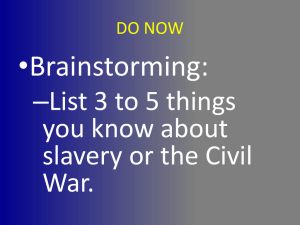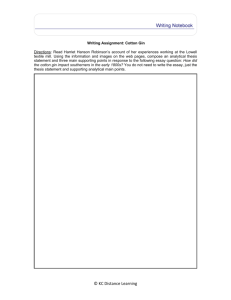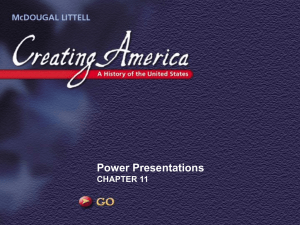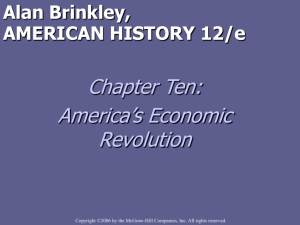Chapters 11_ 12_ 13_ 14 - Chicago High School for Agricultural
advertisement
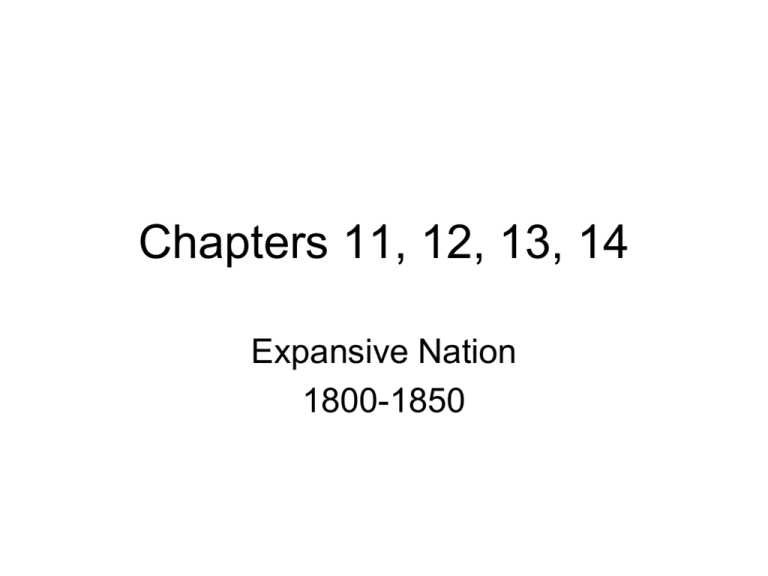
Chapters 11, 12, 13, 14 Expansive Nation 1800-1850 Chapters 11, 12, 13, 14 Expansive Nation Overview • • • • • • • • Changes in Transportation Industrial Revolution/Factory System Reform Slavery Culture/Religion Age of Jackson Native Americans Manifest Destiny/Westward Movement Steam Power/ Steamships ***cheaper and faster to move goods Changes in Transportation Roads Cumberland Road runs from Maryland to Ohio – 1833 (***state and federal $ used) Canals • Erie Canal connects Lake Erie to New York City – 1825 • 3,000 miles of canals in use – 1840 *** lower food prices in East, more immigrants moving West, stronger economic ties between sections) Railroads B & O – first national railroad ***changed towns like Chicago into big commercial centers Railroads Democracy in America (1835-40), Alexis de Tocqueville wrote, “The Americans always display a clear, free, original, and inventive power of mind.” What about our situation allowed for industry to surpass all other nations in the world by the end of the 1800s? Industrial Revolution • British inventors began to make textiles with machines. • A British textile worker, Samuel Slater, set up a textile factory in Rhode Island in 1790. • This was the beginning of the Industrial Revolution in the U.S.! When factories replace work done by hands – mass production Factory System • Lowell Mills – model – Employed white, teenage farm girls – Lived in mills in highly regulated environment – Work protests and strikes organized over wage cuts Harriet Robinson: Lowell Mill Girls Author: Place and Time: Prior Knowledge: Audience: Reason: The Main Idea: Significance: Factory System Causes •Trade Embargo •War of 1812 •Tariffs enacted by Congress •1811 – New York passed law allowing incorporation allowing for big capital to expand business •Immigration – constant work force •New inventions Patents 1790 to 1840 = 11,500 1840 to 1900 = 682,000 Effects •Worker exploitation •12 hour days – six days a week were norm •Development of poor working class •End of self-sufficient household •Changed family structure women and children worked •Led to growth in financial businesses – banking and insurance •First unions created •Gap between wealthy and poor increased •Rapid growth of cotton industry AP Test Questions Transportation and Industrialization Discuss the impact of the “transportation revolution,” 1820 – 1860, on the U.S. (1973) In the period 1815 to 1860, improvements in transportation and increased interregional trade should have united Americans, but instead produced sectional division and finally disunion. Discuss with reference to the impact of improved transportation and increased inter-regional trade on the Northeast (New England and Middle Atlantic states), the South, and the West. (1980) Developments in transportation, rather than in manufacturing and agriculture, sparked American economic growth in the first half of the nineteenth century. Assess the validity of this statement. (1989) Cities • • • • • • 9 of 10 largest cities in North Unsafe No police force until 1830s No water service No sanitation Immigration – north and west of Europe – Potato famine in Ireland 1845-1850 – Failed German Revolution in 1848 – Nativism -> anti-immigrant – Know-Nothings Political Party Reform Movements Public Schools Horace Mann – Massachusetts Believed all humans had right to education Created grade levels with trained teachers Care for Mentally ILL Dorthea Dix – Massachusetts Reported on poor treatment of mentally ill to state gov’t Other Reforms Prison, hospitals, orphanages, alcohol ban (temperance movement), abolition, women’s rights Middle Passage = Atlantic Crossing Estimated that between 1.5 to 2 million slaves died during the journey • Took about six weeks • Slaves shackled to each other • 10-15% died during trip (disease, starvation, suicide, weather) End of Slave Trade - Slavery • 1808 - Britain and US outlaw slave trade • 1833 - Britain abolishes slavery in British territories • 1848 – France abolishes slavery in its colonies • 1865 – U.S. abolished slavery • 1888 – Brazil abolishes slavery (last in Americas) Cotton Gin It was difficult to make a profit from cotton because cottonseeds were removed by hand. Fact = It took one person an entire day to clean one pound of cotton. Cotton Ball, picked 1915 Georgia Eli Whitney invented the cotton gin (short for engine) in 1793. Eli Whitney’s cotton gin. Effects of the Cotton Gin • Plantation owners began to earn a lot of money growing cotton • It increases their dependency on slave labor. Abolitionist Movement People against slavery – 2nd Great Awakening fueled belief that slavery was a sin. • American Colonization Society – transport freed slaves back to Africa • American Anti-Slavery Society – 1831 Started by William Lloyd Garrison -The Liberator • Black Abolitionists Fredrick Douglass - North Star Harriet Tubman, Sojourner Truth Religion – Second Great Awakening Revivals • • Reaction to rationalism, Age of Enlightenment Presbyterian 1823 Charles Finney from New York Appealed to emotions and fear of damnation Baptists and Methodists South and West – traveling preachers By 1850, they had become the largest Protestant denominations in country Literature - Transcendentalists After War of 1812, nationalism produced material that was about American themes Writers that questioned capitalism and church teachings Ralph Waldo Emerson – do not imitate European culture, create new American culture (American Scholar) Henry David Thoreau – use nature to discover truths(Walden) Communal Experiments Shakers – 6,000 members by 1840s Held common property, strictly separated sexes Died out by mid-1900s New Harmony – nonreligious, Indiana, reaction to inequity created by Industrial Revolution, Robert Owen, utopian socialism Oneida – John Humphrey Noyes, Oneida, NY, shared property, economic equality, shared marriage partners, made silverware Account for the emergence of utopian communities from the mid-1820's through the 1840's and evaluate their success and/or failure. (74) American reform movements between 1820 and 1860 reflected both optimistic and pessimistic views of human nature and society. Assess the validity of this statement in reference to reform movements of THREE of the following areas: Education Temperance Women's Rights Utopian experiments Penal institutions (88) In what ways did the early nineteenth-century reform movements for abolition and women's rights illustrate both the strengths and weaknesses of democracy in the early American republic? (93) Analyze the ways in which TWO of the following influenced the development of American society. Puritanism during the seventeenth century The Great Awakening during the eighteenth century The Second Great awakening during the nineteenth century (94)

